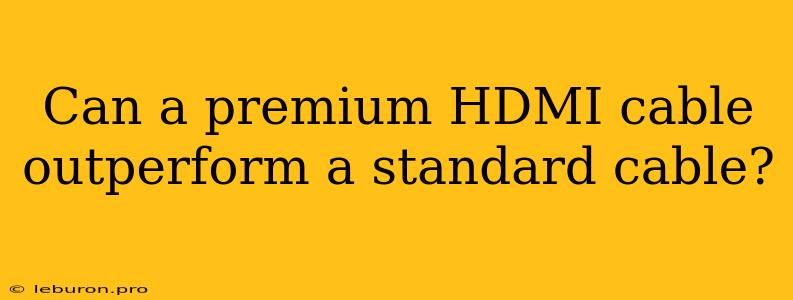The world of audio-visual technology is constantly evolving, with new advancements emerging seemingly every day. One area of particular interest for enthusiasts is the humble HDMI cable, the unsung hero connecting our TVs, gaming consoles, and other devices. With the rise of 4K, 8K, and even higher resolutions, a common question arises: can a premium HDMI cable truly outperform a standard cable, or are they merely a marketing ploy? This article delves into the technical aspects of HDMI cables and explores the potential benefits and limitations of premium options, providing a comprehensive guide to help you make informed decisions for your home theater setup.
Understanding HDMI Cables: The Basics
HDMI, short for High-Definition Multimedia Interface, is a digital interface standard that transmits both audio and video signals between devices. It has become the ubiquitous choice for connecting high-definition displays, thanks to its versatility, ease of use, and high bandwidth capabilities. However, not all HDMI cables are created equal. There are different versions of the HDMI standard, each offering varying levels of bandwidth and features.
HDMI Versions and Their Capabilities:
- HDMI 1.0 (2002): The original standard, supporting up to 1080p resolution and uncompressed 8-channel audio.
- HDMI 1.1 (2004): Introduced support for DVD-Audio and Super Audio CD (SACD).
- HDMI 1.2 (2004): Enhanced audio capabilities, including Dolby Digital Plus and DTS-HD Master Audio.
- HDMI 1.3 (2006): Expanded bandwidth to support 1080p resolution at 120Hz and 1440p resolution at 60Hz.
- HDMI 1.4 (2009): Introduced support for 3D video, 4K resolution, and the Audio Return Channel (ARC).
- HDMI 2.0 (2013): Significantly increased bandwidth to support 4K resolution at 60Hz with high dynamic range (HDR) and expanded audio capabilities.
- HDMI 2.1 (2017): Further increased bandwidth to support 8K resolution at 60Hz, variable refresh rate (VRR), and other advanced features for gaming.
The Role of Cable Quality
While the HDMI version determines the maximum signal that can be transmitted, the quality of the cable itself plays a crucial role in ensuring that signal integrity remains intact. This is where the debate surrounding premium HDMI cables comes into play.
Can a premium HDMI cable outperform a standard cable? The answer is a nuanced one. In most cases, a standard HDMI cable, especially if it is certified by reputable organizations like HDMI Licensing Administrator (HDMI LA), will be sufficient for delivering the highest quality signal that your equipment can handle. This is because modern HDMI cables are designed to carry the signal without significant degradation, even at high bandwidths.
However, there are specific situations where a premium HDMI cable might offer a slight advantage:
1. Long Cable Runs: When using an HDMI cable longer than 15-20 feet, signal attenuation (loss of signal strength) can become more noticeable, especially at higher resolutions. Premium cables often utilize thicker gauge conductors and shielding to minimize signal loss over longer distances.
2. High Bandwidth Applications: For demanding applications like 8K gaming or high-frame-rate video, the minimal difference in signal quality between standard and premium cables might be more pronounced. Premium cables often use high-quality materials and construction methods to ensure optimal signal transmission.
3. Electromagnetic Interference (EMI): In environments with high levels of electromagnetic interference, premium cables with better shielding can help to minimize the impact of EMI on the signal.
4. Perception of Quality: Many users perceive that premium HDMI cables deliver a better visual experience, even if the objective difference is negligible. This perception can be attributed to factors such as brand reputation, price, and perceived value.
Key Features of Premium HDMI Cables
Here are some features that often differentiate premium HDMI cables from standard options:
- Thicker Gauge Conductors: Thicker gauge conductors are used to minimize signal loss and ensure better conductivity.
- Better Shielding: Premium cables often use multi-layer shielding to protect the signal from EMI and interference.
- Gold-Plated Connectors: Gold-plated connectors provide improved conductivity and resist corrosion, ensuring reliable connections.
- Enhanced Construction: Premium cables often utilize high-quality materials and construction methods to ensure durability and longevity.
The Bottom Line: Should You Invest in a Premium HDMI Cable?
The decision of whether to invest in a premium HDMI cable ultimately depends on your specific needs and budget. If you are using a short HDMI cable (under 15 feet) for standard 1080p or 4K content, a standard certified HDMI cable will likely suffice.
However, if you are using a long cable run, pushing the limits of high bandwidth applications, or operating in an environment with high levels of EMI, a premium HDMI cable might offer a slight improvement in signal quality and performance. Remember to always consider your individual requirements and choose the cable that best suits your specific needs and budget.
Conclusion
While premium HDMI cables may offer subtle advantages in specific scenarios, they are not a guaranteed solution for significantly enhancing the quality of your audio-visual experience. Standard HDMI cables, especially those certified by reputable organizations, are capable of delivering excellent performance for most users. However, if you are willing to invest in a premium cable, the potential for improved signal quality and performance, particularly in challenging environments or for high-bandwidth applications, may be worth considering. Ultimately, the best way to determine the right choice for your setup is to consider your specific needs and budget and make an informed decision based on the information available.
